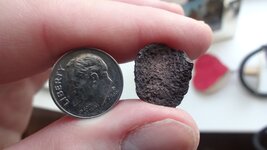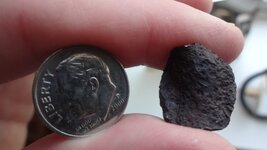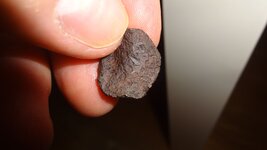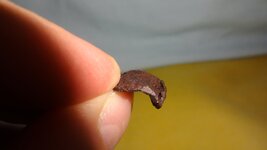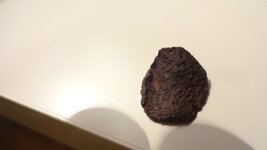Hi,
My young son and I recently found this humble little coin in our yard, about 5" down. We live in on a block in Salem, MA, that has been populated since the 1600s. Definitely a historic neighborhood!
I didn't even think was a coin when we first dug it up, but upon dropping it on a table and hearing the unmistakable "coin" sound, I cleaned it and was pretty convinced I'd found an old coin of some sort.
Maybe one of the many miscellaneous European coppers used in the colonies in the 1600s and 1700s?
As the pictures show, it's about the size of a dime. Probably copper, from little shining bits of color that seem copper-color. REALLY corroded - hardly any features visible. And badly bent. What strikes me is that if I were to unbend the coin to see it flat again, it would not be a perfect circle. This irregular shape made me wonder if this coin could be an old hammered copper - 1600s or 1700s. And the extent of the corrosion made we think it's been in the ground for a longer - rather than shorter - time.
But I am prepared for the verdict that this is just a random piece of metal! I'm new to metal detecting!
Would be great to hear from others as to what (very roughly!) they think this coin could be.
Best,
Greg.
My young son and I recently found this humble little coin in our yard, about 5" down. We live in on a block in Salem, MA, that has been populated since the 1600s. Definitely a historic neighborhood!
I didn't even think was a coin when we first dug it up, but upon dropping it on a table and hearing the unmistakable "coin" sound, I cleaned it and was pretty convinced I'd found an old coin of some sort.
Maybe one of the many miscellaneous European coppers used in the colonies in the 1600s and 1700s?
As the pictures show, it's about the size of a dime. Probably copper, from little shining bits of color that seem copper-color. REALLY corroded - hardly any features visible. And badly bent. What strikes me is that if I were to unbend the coin to see it flat again, it would not be a perfect circle. This irregular shape made me wonder if this coin could be an old hammered copper - 1600s or 1700s. And the extent of the corrosion made we think it's been in the ground for a longer - rather than shorter - time.
But I am prepared for the verdict that this is just a random piece of metal! I'm new to metal detecting!
Would be great to hear from others as to what (very roughly!) they think this coin could be.
Best,
Greg.


